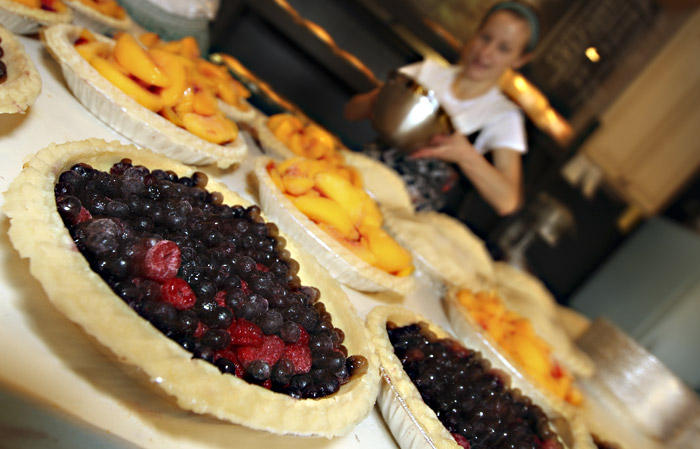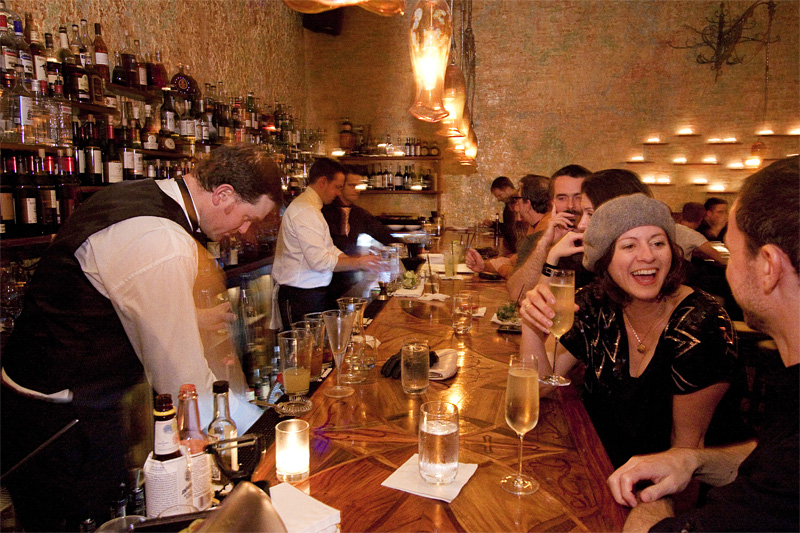For much of Seattle, late summer is the season of too much. The season of overburdened branches, yards strewn with rotting fruit, and empty shelves in the canning sections of supermarkets. The season when mysterious bowls appear in office lunchrooms with a desperate “Free!!!!” sign. The season when neighbors who think they’re going to receive a handful of plums are handed a swollen shopping bag, soaked in the corners with juice.
This is the season of pie.
The June strawberries are gone and the pie cherries—if you ever found them—an expensive memory. The markets are still rich in raspberries, blueberries, peaches, and the omens of the oncoming apple glut, as well as the occasional box of more esoteric pie fruits like gooseberries and huckleberries. Seattle’s food bloggers have stirred up a frenzy around the joys of canning, and many of us are pickling more seriously than we ever have, but pies—good pies—seem to be hard to find. Why?
For the reason that pie disappeared from restaurant menus in the 1970s and ’80s, ceding ground to the crisp and the crumble: fear of pastry. Seattle isn’t a pieless city, but it’s one where pie is perhaps at its nadir, even at a time when the interest in fresh, local food is at its peak. There are glimmers of a comeback: a couple of new pie bakeries, a cooking teacher devoted to pies.
We need more.
My Midwestern childhood memories are larded up with pies. The fresh strawberry pies, with fat dollops of barely thawed Cool Whip, that marked early summer dinners, and which my mother continues to make, though she scoops out a curl of soy ice cream to go on the side. The pie table at church potlucks and the dozens of French crumb apple pies our congregation baked for the annual Mennonite relief fundraiser sale. The brown-bag apple pie that my mother taught me in college, and which I still make every now and again with a mix of heirloom apples from the farmers market.
To me, pie crust should not be a neutral element. You should taste the fat and wheat in it, as well as feel the crust slake apart, rasping your tongue as the sheets of dough come apart. The argument over how to make a good pie crust pops up now and then in the media, sparked by a fad like vodka or duck-fat crusts, and the debate holds as much interest for non-pie makers as a fantasy-football debate in ballet school. Crsut-making is almost an elitist pursuit.
Jenny Christensen may have had to shut down her Pies by Jenny farmers market stand because she couldn’t make the money work, even charging $30 for her big, organic-fruit-filled pies. But you can’t cheap out, either. The least expensive pies I tasted this past month—a $10 organic peach pie from the Whole Foods bakery in South Lake Union and the $3.50 mini-pies and “flipside” turnovers by High 5 Pie, which pie-maker Dani Cone sells out of her Fuel cafes—didn’t satisfy the craving precisely because of the crust. The pies have sat on the shelves so long that their all-butter or butter-and-shortening crusts have softened into mere dough. (Also, there’s enough flour and cornstarch in the fillings to turn them gummy.) The $18 Whidbey Pies marionberry and peach pies I picked up from Metropolitan Market, baked by the famed cafe in Greenbank, tasted wonderful—just enough sugar to balance the acidity of the fillings, giant chunks of soft fruit with vivid flavor—but from their stolid, only somewhat crumbly crusts I could tell they would have been twice as good before they were packed in plastic and stored in a refrigerated case.
No, pie has to be fresh, and the closer to the oven you consume it, the better.
Pocket-sized Shoofly Pie in West Seattle became the first all-pie shop to open in town in July 2007, and Kimmy Hsieh Tomlinson is a proponent of the all-butter crust in her quiches, pot pies, and desserts (check her Web site for the season’s menu). The butter caramelizes slightly as it cooks, and when her crust is fresh, it breaks apart in long, delicate shards. Her recipe shows best in her cream pies, when she bakes the crust separately, then fills it, say, with banana custard and whipped cream. And her cherry pie has the perfect balance of sweet to savory, crunch to gush. But butter crusts seize up quickly, and in the double-crusted pies that bake the longest (apple) or contain the cake-like shoofly filling, the crust seems to solidify into a brick.
Closer to the pie shops of my childhood is the brand new Seattle Pie Company on Magnolia’s commercial strip. With its simple wood paneling and black walls, tabletop burners next to the counter for making Swedish pancakes, and a decor that’s evolved each time I’ve visited, it’s clearly a shoestring operation—a literal mom-and-pop shop, except that owners Alyssa and Patrick Lewis have a few years to go before they even hit 40. Alyssa, who learned to bake at the Snohomish Pie Company, calls large grown men “darlin’.” It’s clearly a conscious choice, but with such a wide smile she charms her way past affectation; instead, you appreciate her nod to tradition. Darlin’ is the perfect pie-lover’s sobriquet.
The baked-fruit smell of the place is fantastic, and it’s hard to look over the dozen pies-by-the-slice in the case or the rows of whole pies on the tall baker’s rack behind the counter without losing all decisiveness. The Lewises make shortening pies, and its neutral, oily flavor is evident, but the crusts crackle and crumble when your fork cuts through. And while the apple pie’s a little sweet, everything else I tasted—plump cherries, deep-purple marionberries, bright peach-raspberry—all hit that point just when tart becomes sweet, so your palate never tires of either, and you just keep forking the slice into your mouth until it’s all gone.
There is something shifty about a berry pie in November, a pumpkin pie in June. It will be interesting to see how Seattle Pie’s offerings change with the season, and how, once winter comes, the Lewises preserve their commitment to Washington fruit (the sour cherries from Michigan that Alyssa uses, she says, are the sole exception).
But if you’re fruit-bombed and frustrated, hitting a pie shop doesn’t solve your overabundance problem. You have to learn to make your own. The problem with pie crust is that, like pasta-making and bread-baking, it’s the simplest skill in the world to people who know how to do it, and seemingly impossible to learn from books. The secret to pie is that it’s all in the eyes and the fingers. After all, the phrase “easy as pie” was never meant sarcastically.
That’s why Kate McDermott, whose new Art of the Pie classes, held in her Magnolia home, teaches her students how to make the perfect crust she’s developed. The classes are not cheap—class size tops off at three, and four hours of instruction cost $125—but they are inspiring as well as effective, and the crust is exquisite. Because she developed the recipe with her husband, Seattle flavor guru Jon Rowley, it has a whiff of the OCD to it, requiring Irish butter and artisanally rendered lard. But the recipe is simpler and more forgiving than you’d expect, because Kate also teaches the sensory aspect of making pies. She shows you how the crumbs of dough should look and feel as you mix them with your hands, and how your ear can tell when the pie is ready to come out of the oven. Her class, in short, makes you feel as if you could saunter through the farmers market, 9-inch pan in your canvas sack, to scout for the most appealing, overabundant fruit. Once you’ve taken the class, Kate encourages you to send her your pie photos, and she says she wants to host a pie social for all her former students. Rebuilding a city of pie bakers. Crust by crust.
This article has been corrected from its original version to reflect that Dani Cone — not Dani Cohn — sells “flipside” turnovers at her Fuel cafes.






